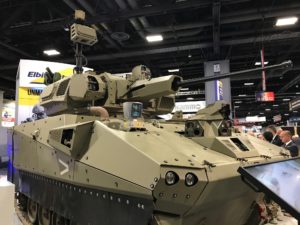Elbit Systems of America has showcased the new Future Fighting Vehicle Technology Demonstrator (FFVD) outfitted with a suite of sensors, including the Iron Vision display capability, to reduce soldier workload and aimed toward Army upgrade efforts and future vehicle programs, such as Robotic Combat Vehicle (RCV).
William Nuckols, Elbit America’s director of ground combat systems, told reporters at last week’s Association of the United States Army conference in Washington the company demonstrated FFVD for Army officials this past August in Israel, with additional events planned for 2020.

“Every one of the systems you see here would have applicability to an Abrams, a Bradley, a Stryker and to the control vehicles for the RCV and, in some cases, directly applicable to the RCV itself,” Nuckols said.
FFVD is integrated with over 45 different sensors and autonomous-driven capabilities that could potentially be used to reduce combat vehicle crew sizes from two to three soldiers, according to Nuckols.
“Each of the systems are pretty impressive on their own. The truly impressive thing that we’ve done with this vehicle is to fully integrate all of them into a system of systems. So it’s not just individual sensors doing a single thing, it’s the synergy of those systems working all together,” Nuckols said. “We have demonstrated that, operationally, you can do it. You can be just as effective, lethal and survivable with a two-man crew as you can with a three-man crew. This shows us the realm of the possible, and we think this is possible.”
Nuckols noted technologies onboard the vehicle can be specifically geared to the Army’s emerging Robotic Combat Vehicle program, both for the autonomous fleet and the control vehicles.
“A lot of the autonomous capabilities that we need for Robotic Combat Vehicle also have direct applicability to manned vehicles, because it gets back to that cognitive burden. If you can help the crew of a manned vehicle better manage the information flow and their decision-making, those kinds of capabilities then apply to unmanned vehicles. It’s kind of like baby steps toward fully autonomous systems,” Nuckols said. “There is some interest in using our Iron Vision system as a way to control the RCVs from a distant location.”
Several companies brought potential offerings for the Army’s RCV programs to the AUSA show, with officials announcing plans to award initial prototype awards next spring (Defense Daily, Oct. 15).
Iron Vision is a 360-degree situational awareness sensor system that Nuckols said acts as “see-through armor” and allows operators to receive real-time, high resolution video on their helmet-mounted display systems.
Israel is set to roll out the capability on their Merkava tanks in 2021, according to Nuckols, who added the capability also provides a picture-in-picture video from other feeds such as tethered UAS, dismounted soldiers or robotic vehicles out in the field.
Additional capabilities showcased on FFVD include the 50mm-capable UT30MK2 turret, the Iron Fist active protection system, the SupervisIR real-time situational awareness sensor and the THOR vertical takeoff and landing mini-UAS.